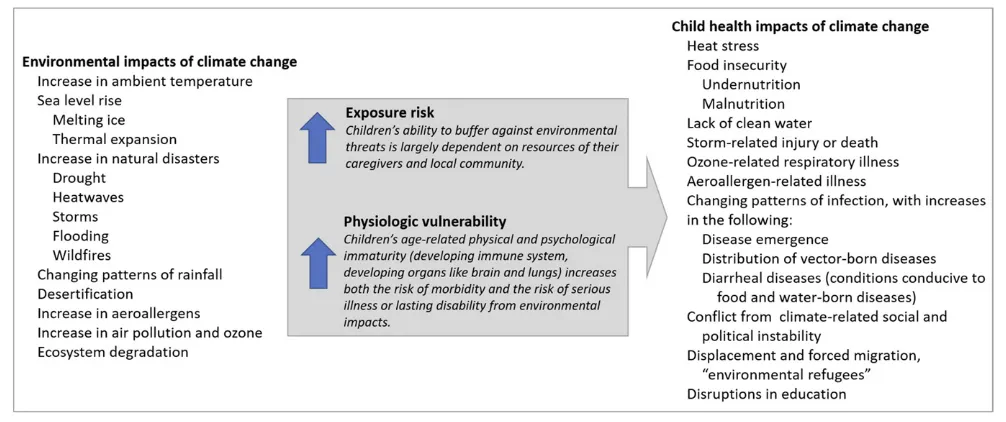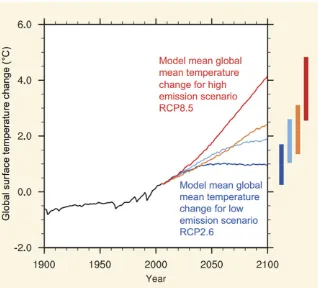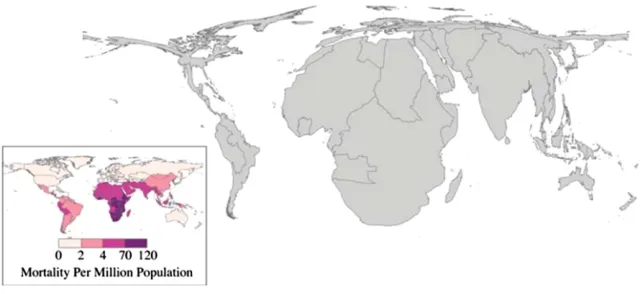Climate Change and Global Child Health
Rebecca Pass Philipsborn, MD, MPA, a, b Kevin Chan, MD, MPHc, dClimate change threatens to reverse the gains in global child health and the reductions in global child mortality made over the past 25 years. There is broad recognition that greenhouse gases emitted by human activities are causing climate change.1, 2 The problem of climate change transcends geopolitical boundaries and will have extensive impacts on child health and security (Fig 1).3 With implications for all of humanity, climate change will disproportionately affect children and the poor, magnifying existing disparities in social determinates of health.4, 5
GLOBAL TEMPERATURE CHANGES AND PROJECTIONS
Changes in temperature and weather patterns are already occurring. Global surface temperatures were the highest ever recorded in 2016, and 9 of the past 10 years were the warmest on record.6 Dramatic changes to the climate are expected to occur within the life span of current pediatric patients. The 2013 Intergovernmental Panel on Climate Change assessed that global temperatures will likely rise 2°C and may increase 4.8°C by 2100 if current trends in emissions continue (Fig 2).2, 7 In the same scenario, the average global sea level rise will accelerate, and seas will likely rise 45 to 82 cm by 2100, relative to 1986–2005
levels.2 Economic damage in the United States is predicted to be 1.2% of gross domestic product for every 1°C increase in temperature.8 Natural disasters will increase in frequency and intensity.2 These climate-related threats are widely considered the most significant global health challenge of our lifetime.9
CLIMATE CHANGE AND CHILD HEALTH
Globally, children are estimated to bear 88% of the burden of disease due to climate change, with the poorest disproportionately affected.10, 11 All children depend on the resources of caregivers and communities to buffer against environmental threats, including climate-related health threats. Children in communities with limited resources to adapt to climate change face an even higher risk of adverse environmental exposure. When exposure results in illness, disability, or death, the loss of potential healthy life is greater for the youngest, resulting in a greater burden of disease measured by disability-adjusted-life-years for children.10 Using projections of the distribution of mortality from climate-related health threats, researchers anticipate a disproportionate impact on the world’s poorest citizens (Fig 3).11
The evident geographic disparity in climate vulnerability likely
aDepartment of Pediatrics, Emory University, Atlanta, Georgia; bEmory Global Health Institute, Atlanta, Georgia; cDepartment of Pediatrics, Memorial University, St John’s, Canada; and dChildren and Women’s Health Program, Eastern Health, St John’s, Canada
Drs Philipsborn and Chan conceptualized the manuscript; drafted, reviewed, revised, and approved the final manuscript as submitted; and agree to be accountable for all aspects of the work.
DOI: https:// doi. org/ 10. 1542/ peds. 2017- 3774 Accepted for publication Jan 19, 2018
Address correspondence to Kevin Chan, MD, MPH, Department of Pediatrics, Memorial University, Room 2J141, 300 Prince Philip Dr, St John’s, NL A1B 3V6, Canada. E-mail: kevin.chan@ easternhealth.ca
PEDIATRICS (ISSN Numbers: Print, 0031-4005; Online, 1098-4275).
Copyright © 2018 by the American Academy of Pediatrics FINANCIAL DISCLOSURE: The authors have indicated they have no financial relationships relevant to this article to disclose.
FUNDING: No external funding.
POTENTIAL CONFLICT OF INTEREST: The authors have indicated they have no potential conflicts of interest to disclose.
overlays a similar age-based disparity: deaths in young children account for a disproportionate share of total deaths due to climate-sensitive health threats. In 2015, deaths in children <5 years old accounted for 38%, 65%, and 48% of global deaths due to diarrhea, malaria, and nutritional deficiencies, respectively.12 The projected increase in these diseases due to climate change corresponds to a considerable burden of preventable child deaths, particularly in low-income countries.
The attributable risk from specific exposures (like extreme heat and ozone) stems not only from the degree of increase but also from the ubiquity of the exposure.13 Researchers estimate that 74% of the world’s population (up from 30% today) will be exposed to at least 20 days of lethal heat per year by 2100 if current emission trends continue.14 Children are particularly vulnerable to extreme heat: they have a high surface area to mass ratio and must divert more cardiac output to their skin to dissipate heat.15 Although variability exists in the literature on heat stress in children, Basagaña et al16 found that
infant mortality increased 25% on extremely hot days, with the first 7 days of life representing a period of critical vulnerability. High ambient temperature coupled with emissions have well-documented negative effects on pulmonary health in children.13, 17 Air pollution decreases total lung volume and has negative impacts on lung function that may be lifelong.18, 19 Increases in ambient temperature and ozone levels directly correlate with pediatric emergency department visits for asthma exacerbation.20, 21 The research on climate and respiratory illness exemplifies the many-faceted implications of climate change on child health. Even in this well-studied realm, there is a dearth of data on children in resource-limited settings, and those children are the least able to modify their exposure risk.
These children are also most vulnerable to scarcity of basic natural resources (potable water and food) aggravated by droughts and flooding. Almost 160 million children live in high or extremely high drought zones and over 500 million inhabit areas with extremely high flood
occurrence.22 Increased amplitudes of drought and flood events are projected to stress agricultural systems, exacerbate food and water insecurity, and increase childhood undernutrition.23, 24 The World Health Organization projects that there will be 77000 to 131000 additional deaths in children under 5 from climate-related undernutrition in 2030.25 Contributing to 45% of total deaths in children <5 years old, undernutrition compromises the immune system and blunts long-term developmental potential.26, 27 Scarcity of rainfall has been linked to environmental conflict.28, 29 Conflict and migration, in turn, further stress the environment, agricultural system, and local populations in a vicious cycle that erodes basic social determinants of health.
Natural disasters also lead to displacement of families and
children. Extreme weather events are increasing in frequency and intensity, undermining the stability of home and community for growing numbers of children, with risks to their security and physical and mental health.3, 30 The Internal Displacement
FIGURE 1
Monitoring Center estimates that more than 26 million people per year have left their homes because of natural disasters since 2008, a likelihood of displacement twice that of 1970.31 Over half of internationally displaced refugees were children.32 Displaced children face substantial health risks, including malnutrition, infection, traumatic stress, and physical or sexual abuse.33 Disasters also disrupt the medical supply chain, compromising vaccination programs and the availability of medications. In 2017, Hurricane Maria disrupted the production of drugs and intravenous fluid manufactured in Puerto Rico, resulting in global shortages.34 The
results of natural disasters are felt globally.
The potential for the rapid spread of infectious diseases in a world connected by global travel and commerce further illustrates the compass of climate change. Among its ecological impacts are anticipated increases in many infectious illnesses, alterations in vector-borne diseases, and more rapid disease emergence.35 Increased temperatures are associated with an increased incidence of bacterial causes of diarrhea.36 The World Health Organization estimates an
additional 48000 deaths per year from diarrheal diseases in children <15 years old by 2030.37 The re-emergence of Chikungunya (with its expansion into the western hemisphere) has been linked to changing climates in Southeast Asia.38 Likewise, warmer climates are thought to have contributed to the Zika virus pandemic, with studies detailing the effect of warmer temperatures on the range, life cycle, and feeding patterns of
Aedes aegypti mosquitos.35
OPPORTUNITIES FOR PEDIATRICIANS
These are select examples of research (and knowledge gaps) on the health impacts of climate change in children. Pediatricians are positioned to reframe this urgent debate from one of political interests to one of monumental global health importance. We must advocate for child-specific research on climate change and health as well as incorporation of child-specific needs in disaster preparedness plans and climate adaptation policies.39 We must be prepared to respond to surges of child injury and illness in the aftermath of a disaster when health infrastructure itself is likely to be compromised. We can lead in adopting climate-friendly practices in our own personal and professional realms, taking stock of our energy, transportation, and food sources and choices.40 Collective acts to prepare for and (most urgently) to limit the magnitude of climate change will help protect children around the globe from preventable illness and death. In the interim, our collective inaction may be to the detriment of those we dedicate our careers to protecting.
ACKNOWLEDGMENT
We recognize the contributions of Michael Forrestor to the research of this article.
FIGURE 2
REFERENCES
1. Anderegg WR, Prall JW, Harold J, Schneider SH. Expert credibility in climate change. Proc Natl Acad Sci
USA. 2010;107(27):12107–12109 2. Intergovernmental Panel on Climate
Change. Climate Change 2014:
Synthesis Report. Contribution of Working Groups I, II, and III to the Fifth Assessment Report of the Intergovernmental Panel on Climate Change. Geneva, Switzerland:
Intergovernmental Panel on Climate Change; 2014:151
3. Ahdoot S, Pacheco SE; Council on Environmental Health. Global climate change and children’s health.
Pediatrics. 2015;136(5). Available at:
www. pediatrics. org/ cgi/ content/ full/ 136/ 5/ e1468
4. McMichael AJ, Campbell-Lendrum D, Kovats S, et al. Global climate change. In: Ezzati M, Lopez AD, Rodgers AA, Murray CJL, eds. Comparative
Quantification of Health Risks: Global and Regional Burden of Disease due to Selected Major Risk Factors. Geneva,
Switzerland: World Health Organization; 2014:1543–1650
5. Levy BS, Patz JA. Climate change, human rights, and social justice. Ann
Glob Health. 2015;81(3):310–322 6. National Oceanic and Atmospheric
Administration, National Centers for Environmental Information. Global
climate report - annual 2016. Available at: https:// www. ncdc. noaa. gov/ sotc/ global/ 201613. Accessed March 27, 2018
7. Collins M, Knutti F, Arblaster J, et al. Long-term climate change: projections, commitments and irreversibility. In: Stocker TF, Qin D, Plattner GK, et al, eds. Climate Change 2013: The Physical
Science Basis. Contribution of Working Group I to the Fifth Assessment Report of the Intergovernmental Panel on Climate Change. Cambridge, United
Kingdom: Cambridge University Press; 2013:1029–1136
8. Hsiang S, Kopp R, Jina A, et al. Estimating economic damage from climate change in the United States.
Science. 2017;356(6345):1362–1369 9. Costello A, Abbas M, Allen A, et al.
Managing the health effects of climate change: Lancet and University College London Institute for
Global Health Commission. Lancet. 2009;373(9676):1693–1733
10. Zhang Y, Bi P, Hiller JE. Climate change and disability-adjusted life years.
J Environ Health. 2007;70(3):32–36 11. Patz JA, Gibbs HK, Foley JA, Rogers JV,
Smith KR. Climate change and global health: quantifying a growing ethical crisis. EcoHealth. 2007;4:397–405 12. GBD 2015 Mortality and Causes of
Death Collaborators. Global, regional, and national life expectancy, all-cause
mortality, and cause-specific mortality for 249 causes of death, 1980-2015: a systematic analysis for the Global Burden of Disease Study 2015. Lancet. 2016;388(10053):1459–1544
13. Perera FP. Multiple threats to child health from fossil fuel combustion: impacts of air pollution and climate change. Environ Health Perspect. 2017;125(2):141–148
14. Mora C, Dousset B, Caldwell IR, et al. Global risk of deadly heat. Nat Clim
Chang. 2017;7(7):501–506 15. Falk B, Dotan R. Children’s
thermoregulation during exercise in the heat: a revisit. Appl Physiol Nutr
Metab. 2008;33(2):420–427
16. Basagaña X, Sartini C, Barrera-Gómez J, et al. Heat waves and cause-specific mortality at all ages. Epidemiology. 2011;22(6):765–772
17. Kim JJ; American Academy of Pediatrics Committee on Environmental Health. Ambient air pollution: health hazards to children.
Pediatrics. 2004;114(6):1699–1707 18. To T, Zhu J, Larsen K, et al; Canadian
Respiratory Research Network. Progression from asthma to chronic obstructive pulmonary disease. Is air pollution a risk factor? Am J Respir
Crit Care Med. 2016;194(4):429–438 19. Gauderman WJ, Avol E, Gilliland
F, et al. The effect of air pollution on lung development from 10 to 18 years of age. N Engl J Med. 2004;351(11):1057–1067
20. Winquist A, Grundstein A, Chang HH, Hess J, Sarnat SE. Warm season temperatures and emergency department visits in Atlanta, Georgia.
Environ Res. 2016;147:314–323 21. Sheffield PE, Knowlton K, Carr JL,
Kinney PL. Modeling of regional climate change effects on ground-level ozone and childhood asthma. Am J Prev Med. 2011;41(3):251–257; quiz A3
22. United Nations Children’s Fund. Unless
We Act Now: The Impact of Climate Change on Children. New York, NY:
United Nations Children’s Fund; 2015 23. Lobell DB, Burke MB, Tebaldi C,
Mastrandrea MD, Falcon WP, Naylor RL. Prioritizing climate change adaptation needs for food security in 2030.
Science. 2008;319(5863):607–610
FIGURE 3
24. Battisti DS, Naylor RL. Historical warnings of future food insecurity with unprecedented seasonal heat. Science. 2009;323(5911):240–244
25. Lloyd S, Kovats S, Chalabi Z. Undernutrition. In: Hales S, Kovats S, Lloyd S, Cambpell-Lendrum D, eds.
Quantitative Risk Assessment of the Effects of Climate Change on Select Causes of Death, 2030s and 2050s.
Geneva, Switzerland: World Health Organization; 2014:69–94
26. Black RE, Victora CG, Walker SP, et al; Maternal and Child Nutrition Study Group. Maternal and child undernutrition and overweight in low-income and middle-low-income countries.
Lancet. 2013;382(9890):427–451 27. World Bank. Repositioning Nutrition
as Central to Development: A Strategy for Large Scale Action: Summary.
Washington, DC: World Bank; 2006 28. Webersik C. Climate Change and
Security: A Gathering Storm of Global Challenges. Santa Barbara, CA:
Praeger; 2010
29. Hsiang SM, Burke M, Miguel E. Quantifying the influence of climate on human conflict. Science. 2013;341(6151):1235367
30. Garcia DM, Sheehan MC. Extreme weather-driven disasters and
children’s health. Int J Health Serv. 2016;46(1):79–105
31. Norwegian Refugee Council Internal Displacement Monitoring Centre. Global estimates 2015: people displaced by disasters. Available at: http:// www. internal- displacement. org/ assets/ library/ Media/ 201507- globalEstimates- 2015/ 20150713- global- estimates- 2015- en- v1. pdf . Accessed September 12, 2017
32. UN High Commissioner for Refugees. Global trends: forced displacement in 2015. Available at: www. unhcr. org/ globaltrends2016/ . Accessed September 12, 2017
33. Owoaje ET, Uchendu OC, Ajayi TO, Cadmus EO. A review of the health problems of the internally displaced persons in Africa. Niger Postgrad Med
J. 2016;23(4):161–171
34. US Food and Drug Administration. Statement by FDA commissioner Scott Gottlieb, M.D., updating on Puerto Rico related medical product shortages. Available at: https:// www. fda. gov/ NewsEvents/ Newsroom/ PressAnnouncement s/ ucm587290. htm. Accessed December 21, 2017
35. Monaghan AJ, Sampson KM, Steinhoff DG, et al. The potential impacts of 21st century climatic and population changes on human exposure to the
virus vector mosquito Aedes aegypti.
Clim Change. 2016;1–14
36. Levy K, Woster AP, Goldstein RS, Carlton EJ. Untangling the impacts of climate change on waterborne diseases: a systematic review of relationships between diarrheal diseases and temperature, rainfall, flooding, and drought. Environ Sci Technol. 2016;50(10):4905–4922
37. Kovats S, Lloyd S. Diarrhoeal disease. In: Hales S, Kovats S, Lloyd S, Cambpell-Lendrum D, eds. Quantitative Risk
Assessment of the Effects of Climate Change on Select Causes of Death 2030s and 2050s. Geneva, Switzerland:
World Health Organization; 2014:37–48 38. Meason B, Paterson R. Chikungunya,
climate change, and human rights.
Health Hum Rights. 2014;16(1):105–112 39. Burgess J. Climate change: children’s
challenge. UNICEF UK climate report 2013. Available at: https:// downloads. unicef. org. uk/ wp- content/ uploads/ 2013/ 09/ unicef- climate- change- report- 2013. pdf?_ ga= 2. 260913805. 1852878664. 1517505729- 1521747984. 1517505729. Accessed July 11, 2017
DOI: 10.1542/peds.2017-3774 originally published online May 8, 2018;
2018;141;
Pediatrics
Rebecca Pass Philipsborn and Kevin Chan
Climate Change and Global Child Health
Services
Updated Information &
http://pediatrics.aappublications.org/content/141/6/e20173774
including high resolution figures, can be found at:
References
http://pediatrics.aappublications.org/content/141/6/e20173774#BIBL
This article cites 26 articles, 7 of which you can access for free at:
Subspecialty Collections
alth_sub
http://www.aappublications.org/cgi/collection/international_child_he International Child Health
sub
http://www.aappublications.org/cgi/collection/environmental_health_ Environmental Health
following collection(s):
This article, along with others on similar topics, appears in the
Permissions & Licensing
http://www.aappublications.org/site/misc/Permissions.xhtml
in its entirety can be found online at:
Information about reproducing this article in parts (figures, tables) or
Reprints
http://www.aappublications.org/site/misc/reprints.xhtml
DOI: 10.1542/peds.2017-3774 originally published online May 8, 2018;
2018;141;
Pediatrics
Rebecca Pass Philipsborn and Kevin Chan
Climate Change and Global Child Health
http://pediatrics.aappublications.org/content/141/6/e20173774
located on the World Wide Web at:
The online version of this article, along with updated information and services, is
by the American Academy of Pediatrics. All rights reserved. Print ISSN: 1073-0397.


